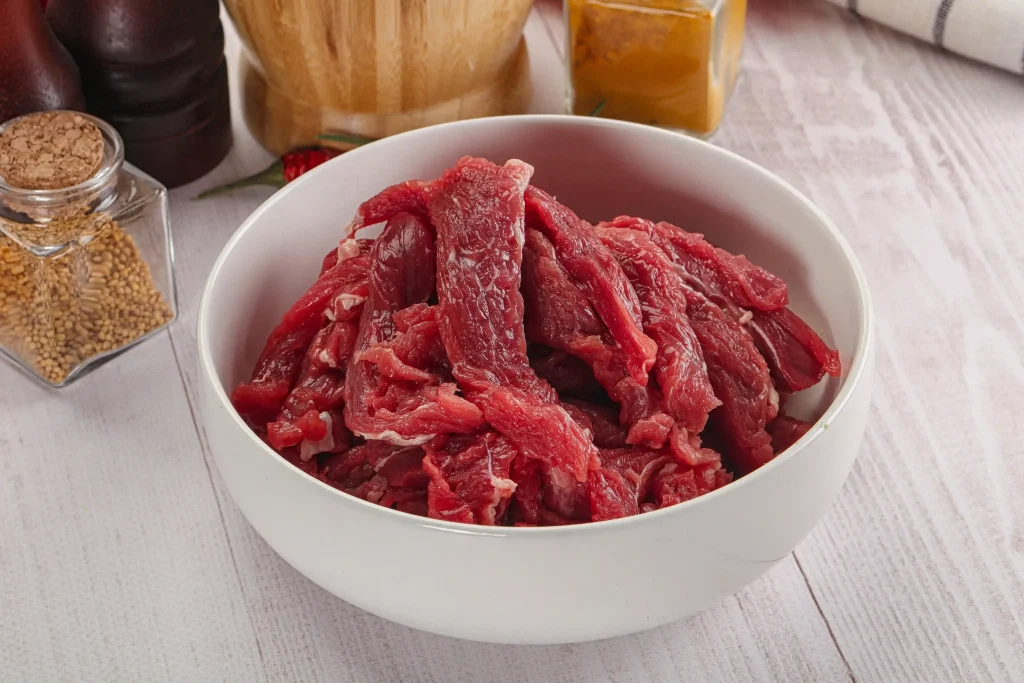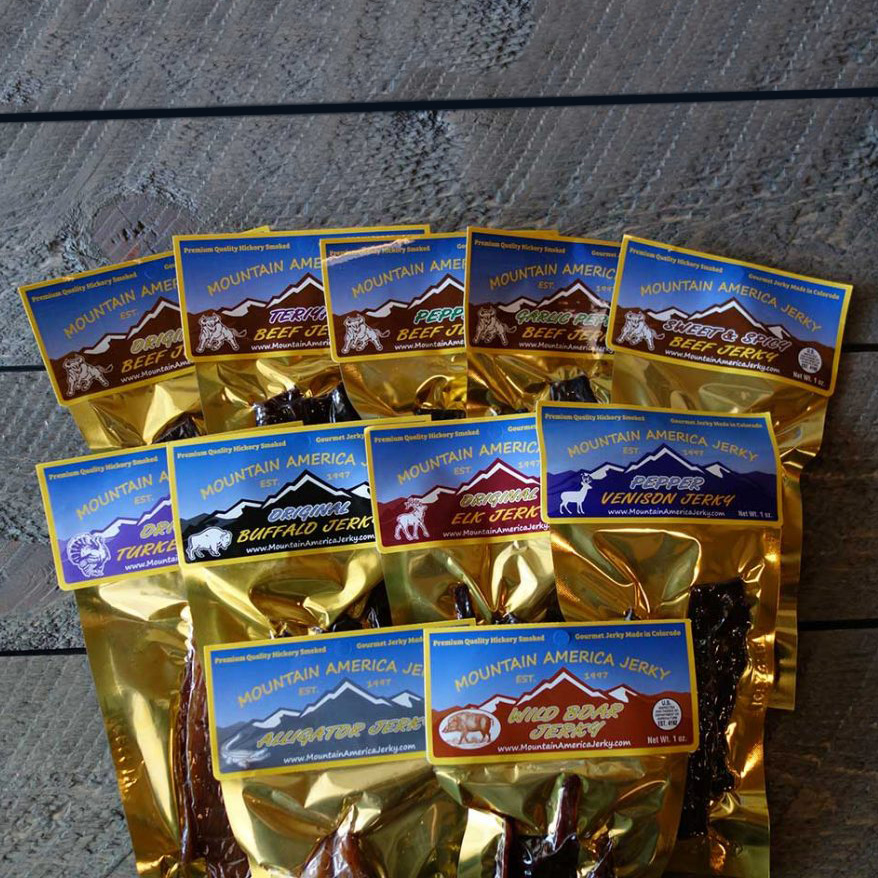How is beef jerky made? This question highlights a culinary tradition that spans thousands of years and cultures across the globe. From ancient Egypt to Central America, dried meats like beef jerky have been essential to survival as a portable, preserved, nutrient-dense food source.
Known by many names, including charqui, quant’a, kilishi, biltong, ch’arki, pemmican, and coppiette, what we call jerky can be made using whatever meat is available — whether beef, alpaca, bison, or fish. The process of making jerky begins with slicing these lean meats into thin strips and marinating them to enhance their flavor and texture. Just as our global ancestors used smoke to prepare their dried meats, the tradition of using smoke to seal in juices and add rich flavor remains a hallmark of quality jerky.
How is beef jerky made?
Beef jerky recipes involve cutting lean meat into thin strips, marinating the strips to impart flavor and improve texture, then cooking, smoking, or dehydrating the meat. Commercially made beef jerky is then packaged to remove oxygen for shelf-stable storage.
This same general process is used for all types of jerky, from salmon to yak. The biggest differences between types of jerky and makers of jerky lie in the marinade flavors and whether the meat is dehydrated or smoked. We believe smoked jerky is the best jerky. Smoking produces a moist, chewy texture and perfectly smoked flavor, so we never dehydrate our products.
How To Make Beef Jerky
The history of beef jerky reveals a longstanding tradition of using wind, sun, and smoke to preserve meat. Global populations traditionally used the meat they had available, leading to virtually endless jerky recipes. Generally speaking, most jerky made today follows a simple set of steps over hours or days.
1. Cut the Meat Into Thin Strips
The first step in making the best beef jerky is choosing the cut of meat you’ll use. Lean cuts like top and bottom rounds are the best cuts of beef for beef jerky because they result in ideal flavors and textures. Once you’ve selected the meat, trim its fat and cut it uniformly into thin strips. Evenly cut strips are key to an evenly cooked product, so getting this step right is critical to making quality jerky.
2. Marinate and Season the Meat
Beef jerky marinades combine wet and dry ingredients to impart flavor and help create an ideal texture. Commonly used wet ingredients include soy sauce, Worcestershire sauce, or teriyaki sauce. Dry ingredients might include salt, ground black pepper, brown sugar, and spices like garlic powder, onion powder, or red pepper flakes. Depending on the desired flavor, additional dry ingredients may be rubbed onto the meat before smoking it.
Fattier cuts, such as those used by cheaper store-bought jerky brands, may also require the use of meat tenderizer or fruit juice. The enzymes in these products can help break down excess fat in the meat, but they don’t necessarily get rid of grizzle. Choosing the proper cut and marinade before smoking the meat greatly impacts the jerky’s texture and flavor.
3. Smoke the Meat Using a Low-And-Slow Process
Perfectly smoked beef jerky is made using a controlled temperature over an extended period. This allows the smoke from the hickory chips to flavor the meat without overwhelming it, as over-smoking can lead to bitterness. The proper balance of heat, time, and smoke is vital to creating a delicious flavor without a bitter aftertaste.
After arranging the jerky strips into a single layer, smoke the meat, poultry, or fish using one of two types of smoking: hot smoking and cold smoking. Hot smoking, which we use for our beef jerky, uses temperatures between 190 and 300 degrees Fahrenheit to cook and smoke meat simultaneously. Cold smoking cures then smokes meat at temperatures under 120 degrees Fahrenheit, and it’s ideal for seafood jerky and smoked cheese.
4. Package the Finished Beef Jerky
Part of what makes jerky so convenient for travel, sports, and camping is that it’s shelf-stable. This means you can store it in the pantry or your bag until it’s opened. While cooking and smoking are part of creating this type of food-safe meat product, proper jerky storage is crucial to peak flavor and freshness as well.
Vacuum sealing, nitrogen flushing, and the use of desiccant packs limit jerky’s exposure to air and moisture. If you’re looking to store homemade beef jerky, opt for an airtight container. To further extend the shelf life of any jerky, protect it from temperature fluctuations by storing it in the refrigerator or freezer.
FAQs
We may have answered the common question, “How is beef jerky made?” But you might still be wondering about additional aspects of beef jerky. Here are answers to some of the most common questions about jerky.
Q. What animal does jerky come from?
The most common type of jerky is beef, which comes from cows. But the options for jerky extend well beyond what you may expect. Some of our other popular jerky products come from buffalo, deer, elk, salmon, alligator, and ostrich.
Q. Is beef jerky raw meat or cooked?
Beef jerky should reach an internal temperature of at least 160 degrees Fahrenheit to be safe to eat. We “cook” our beef jerky by smoking it until it reaches the proper internal temperature and moisture content required by the USDA.
Q. Can I eat beef jerky while pregnant?
Whether (and how much) jerky you can eat depends on a few factors. For more information, check out our post, Can You Eat Beef Jerky While Pregnant?
What makes Mountain America jerky different?
Mountain America jerky is 100% handmade, MSG- and nitrate-free jerky. We start with high-quality, whole-muscle, solid strips of meat, which we smoke in our Colorado smokehouse daily. We don’t use any fillers or binders, and because we care about the quality of the products we produce as well as your health, we use less salt than most commercial jerky makers. As a family, we’ve been focused on maintaining excellence in the meat industry for generations.
Mountain America offers a complete line of common and exotic jerky that furthers our family’s traditions. In addition to beef jerky, we have fish and game options and flavors focused on additional spiciness or sweetness. To find your favorite, we recommend starting with a sampler pack or joining the jerky of the month club. If you’re putting together a gift, consider adding some of our gourmet smoked cheese or a bar of soap.


Leave a Reply